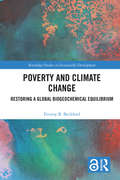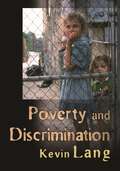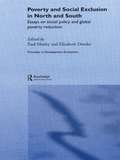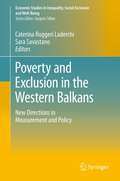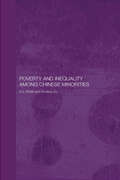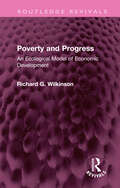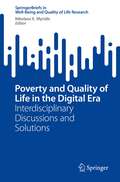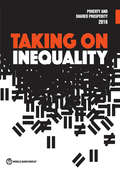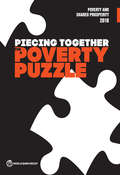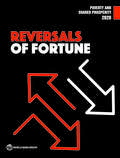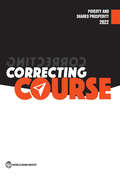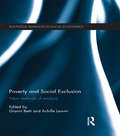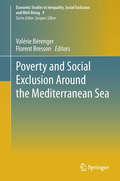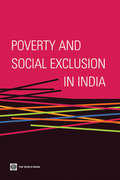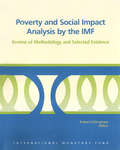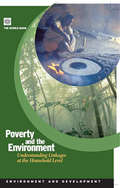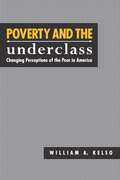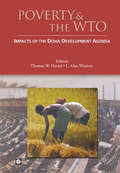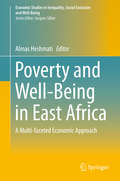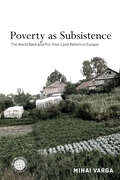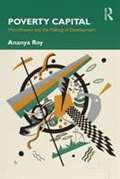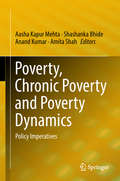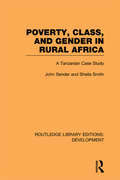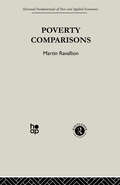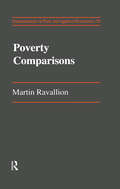- Table View
- List View
Poverty and Climate Change: Restoring a Global Biogeochemical Equilibrium (Routledge Studies in Sustainable Development)
by Fitzroy B. BeckfordMost, if not all of the global biogeochemical cycles on the earth have been broken or are at dangerous tipping points. These broken cycles have expressed themselves in various forms as soil degradation and depletion, ocean acidification, global warming and climate change. The best proposal for an organic solution to fixing the myriad broken cycles is a deliberate investment in solutions that first acknowledge the historic roles played by both the subjugated peoples, and the economic beneficiaries of the environmental exploitations of the past. Ever since Europeans made contact with the West, a series of global circumstances including the genocide of the indigenous people of the Americas, the enslavement and global subjugation of Africans, and the emergence of Western concepts of trade dominance and capitalism, have led to deleterious impacts on the global biogeochemical cycles. Addressing the broken biogeochemical cycles should be done with a clear understanding that it was not only human subjects which were subjugated, but also land, water, and air. These three global stores must be replenished from the ideological position that poverty is not simply the absence of money, but is also the lack of access to non-polluting energy sources, to clean air devoid of runaway greenhouse gasses, and to local conditions devoid of climate change instabilities. With this in mind, the global powerbrokers can enter into a new deal with developing nations, shifting the paradigm toward a new ecological approach that rewards good behavior and sets new standards of worldwide relations based on ecologic inclusivity rather than the exclusive economic arrangements currently in order. Harnessing a forward thinking approach to analyzing the current global environmental crisis, this book will be of great interest to students and scholars of sustainable development, political ecology, sustainable agriculture, climate change and environmental justice.
Poverty and Discrimination
by Kevin LangMany ideas about poverty and discrimination are nothing more than politically driven assertions unsupported by evidence. And even politically neutral studies that do try to assess evidence are often simply unreliable. In Poverty and Discrimination, economist Kevin Lang cuts through the vast literature on poverty and discrimination to determine what we actually know and how we know it. Using rigorous statistical analysis and economic thinking to judge what the best research is and which theories match the evidence, this book clears the ground for students, social scientists, and policymakers who want to understand--and help reduce--poverty and discrimination. It evaluates how well antipoverty and antidiscrimination policies and programs have worked--and whether they have sometimes actually made the problems worse. And it provides new insights about the causes of, and possible solutions to, poverty and discrimination. The book begins by asking, "Who is poor?" and by giving a brief history of poverty and poverty policy in the United States in the twentieth century, including the Welfare Reform Act of 1996. Among the topics covered are the changing definition of poverty, the relation between economic growth and poverty, and the effects of labor markets, education, family composition, and concentrated poverty. The book then evaluates the evidence on racial discrimination in areas such as education, employment, and criminal justice, as well as sex discrimination in the labor market, and assesses the effectiveness of antidiscrimination policies. Throughout, the book is grounded in the conviction that we must have much better empirical knowledge of poverty and discrimination if we hope to reduce them.
Poverty and Exclusion in North and South: Essays on Social Policy and Global Poverty Reduction (Priorities for Development Economics)
by Paul Mosley Elizabeth DowlerOver the past decade there has been a worrying increase in poverty in the industrialised countries of the "North", while many of the developing countries of the "South" have experienced some improvement. This collection argues that there are a number of likenesses between the predicaments of North and South, and that these warrant further investigation and analysis.
Poverty and Exclusion in the Western Balkans
by Caterina Ruggeri Laderchi Sara SavastanoThis book maps the latest developments in the policy relevant analysis on poverty, inclusion and the social agenda in the Western Balkans. It does so by presenting a selection of recent papers which explore from a methodological and analytical point of view how the inclusion agenda can be monitored and adapted to understand the challenges in the region. The volume includes an overview and four sections, covering respectively: (1) innovations in terms of measurement of poverty and inclusion in the region (the concept of inclusion as elaborated at the EU level, innovations in survey design to suit the measurement of inclusion, methodological insights from qualitative work); (2) innovative country level analysis (updating poverty mapping in inter-censual years, the analysis of material deprivation, the analysis of determinants of social inclusion, subjective wellbeing of public work programs participants); (3) examples of country level analysis of drivers of exclusion (barriers to formalization in the labour market, gender disparities in the labour market, disruption in social networks following urbanizations, attitudes towards multi-ethnic states); (4) building inclusive safety nets (an assessment of safety nets in the region, the political economy of welfare reform, micro-simulations of social assistance reform, the adoption of better tools to improve targeting performance). The chapters combine sophisticated techniques which are at the frontiers of poverty analysis (small area estimation, efficiency analysis applied to household welfare, micro-simulations) with less ground-breaking papers which take advantage of innovative datasets or perspectives deeply grounded in the policy dialogue in the countries of the region. By providing a wide spectrum of innovative and policy relevant analytical contributions this book will be of broader interest than for observers of the region.
Poverty and Inequality among Chinese Minorities (Routledge Studies on the Chinese Economy)
by Ajit S. Bhalla Shufang QiuThe number of poor people in China is huge, despite recent economic advances. The minorities in China constitute less than ten per cent of the entire population, yet they represent forty to fifty per cent of the absolute poor. This compelling book investigates the problem of poverty and inequality in and among Chinese ethnic minorities, focusing in particular on two important questions: Have the minorities shared the fruits of spectacular economic growth in China during the past two decades? Is their backwardness due to ethnic and cultural factors or to extremely low incomes? The authors examine the different factors explaining poverty, the relationship between poverty and ethnicity, poverty indicators that permit a comparison between minorities and non-minorities (or the Han majority), economic and demographic characteristics of minorities and their educational, occupational and gender profiles. They consider whether special measures in favour of minorities introduced by the Chinese government have contributed to an improvement in their standard of living. Poverty and Inequality among Chinese Minorities gives original research findings and new thinking on a highly topical issue in Chinese development economics, and fills a gap in the existing economic literature.
Poverty and Progress: An Ecological Model of Economic Development (Routledge Revivals)
by Richard G. WilkinsonOriginally published in 1973 and now reissued with a new Preface, this striking book challenges the whole structure of our thinking on how societies develop – why some are primitive and others advanced. It demonstrates that the pursuit of progress is not the real driving force behind change. Economic development, it argues, is simply the escape route of societies caught in the ecological pincers of population growth and scarce resources. The author explains the processes by which industrialization is forced upon societies by the progressive scarcity of all land-based resources. The things we think of as the fruits of man's search for progress including increasingly sophisticated technology, labour-saving machinery and the rest - are in fact part of the struggle to keep up with the growing productive task created by ecological pressures. ln this light primitive societies appear less poor than we imagine, and advanced ones less rich.
Poverty and Quality of Life in the Digital Era: Interdisciplinary Discussions and Solutions (SpringerBriefs in Well-Being and Quality of Life Research)
by Nikolaos E. MyridisThis book proposes new solutions to the problem of poverty, and begins with providing analyses. It bases most of the analyses and solutions in the context of the digital era. The book also follows, in addition to a scientific distribution, a spatial-geographical one: analyses of countries of the European Union as well as South Africa, while it referring to two main variables, television and art, as agents of poverty alleviation. The book places particular focus on how poverty is understood in the framework of Industry 4.0. It introduces a new expanded Multidimensional Poverty Index with more than 20 dimensions; moreover, it provides a mathematically based solution for the disposal of perishable food. Finally, it does not disregard the crucial aspect of the issue of poverty: that of education planning. This book is of interest to specialists in poverty research, from students to professionals and from professors to activists, without excluding engineers.
Poverty and Shared Prosperity 2016: Taking on Inequality
by World Bank GroupPoverty and Shared Prosperity 2016 is the first of an annual flagship report that will inform a global audience comprising development practitioners, policy makers, researchers, advocates, and citizens in general with the latest and most accurate estimates on trends in global poverty and shared prosperity. This edition will also document trends in inequality and identify recent country experiences that have been successful in reducing inequalities, provide key lessons from those experiences, and synthesize the rigorous evidence on public policies that can shift inequality in a way that bolsters poverty reduction and shared prosperity in a sustainable manner. Specifically, the report will address the following questions: * What is the latest evidence on the levels and evolution of extreme poverty and shared prosperity? * Which countries and regions have been more successful in terms of progress toward the twin goals and which are lagging behind? * What does the global context of lower economic growth mean for achieving the twin goals? * How can inequality reduction contribute to achieving the twin goals? * What does the evidence show concerning global and between- and within-country inequality trends? * Which interventions and countries have used the most innovative approaches to achieving the twin goals through reductions in inequality? The report will make four main contributions. First, it will present the most recent numbers on poverty, shared prosperity, and inequality. Second, it will stress the importance of inequality reduction in ending poverty and boosting shared prosperity by 2030 in a context of weaker growth. Third, it will highlight the diversity of within-country inequality reduction experiences and will synthesize experiences of successful countries and policies, addressing the roots of inequality without compromising economic growth. In doing so, the report will shatter some myths and sharpen our knowledge of what works in reducing inequalities. Finally, it will also advocate for the need to expand and improve data collection--for example, data availability, comparability, and quality--and rigorous evidence on inequality impacts in order to deliver high-quality poverty and shared prosperity monitoring.
Poverty and Shared Prosperity 2018: Piecing Together the Poverty Puzzle (Poverty and Shared Prosperity)
by World BankThe World Bank Group has two overarching goals: End extreme poverty by 2030 and promote shared prosperity by boosting the incomes of the bottom 40 percent of the population in each economy. As this year’s Poverty and Shared Prosperity report documents, the world continues to make progress toward these goals. In 2015, approximately one-tenth of the world’s population lived in extreme poverty, and the incomes of the bottom 40 percent rose in 77 percent of economies studied. But success cannot be taken for granted. Poverty remains high in Sub- Saharan Africa, as well as in fragile and conflict-affected states. At the same time, most of the world’s poor now live in middle-income countries, which tend to have higher national poverty lines. This year’s report tracks poverty comparisons at two higher poverty thresholds—$3.20 and $5.50 per day—which are typical of standards in lower- and upper-middle-income countries. In addition, the report introduces a societal poverty line based on each economy’s median income or consumption. Poverty and Shared Prosperity 2018: Piecing Together the Poverty Puzzle also recognizes that poverty is not only about income and consumption—and it introduces a multidimensional poverty measure that adds other factors, such as access to education, electricity, drinking water, and sanitation. It also explores how inequality within households could affect the global profile of the poor. All these additional pieces enrich our understanding of the poverty puzzle, bringing us closer to solving it. For more information, please visit worldbank.org/PSP
Poverty and Shared Prosperity 2020: Reversals of Fortune (Poverty and Shared Prosperity)
by World BankThis edition of the biennial Poverty and Shared Prosperity report brings sobering news. The COVID-19 (coronavirus) pandemic and its associated economic crisis, compounded by the effects of armed conflict and climate change, are reversing hard-won gains in poverty reduction and shared prosperity. The fight to end poverty has suffered its worst setback in decades after more than 20 years of progress. The goal of ending extreme poverty by 2030, already at risk before the pandemic, is now beyond reach in the absence of swift, significant, and sustained action, and the objective of advancing shared prosperity—raising the incomes of the poorest 40 percent in each country—will be much more difficult. Poverty and Shared Prosperity 2020: Reversals of Fortune presents new estimates of COVID-19's impacts on global poverty and shared prosperity. Harnessing fresh data from frontline surveys and economic simulations, it shows that pandemic-related job losses and deprivation worldwide are hitting already poor and vulnerable people hard, while also shifting the profile of global poverty to include millions of 'new poor.' Original analysis included in the report shows that the new poor are more urban, better educated, and less likely to work in agriculture than those living in extreme poverty before COVID-19. It also gives new estimates of the impact of conflict and climate change, and how they overlap. These results are important for targeting policies to safeguard lives and livelihoods. It shows how some countries are acting to reverse the crisis, protect those most vulnerable, and promote a resilient recovery. These findings call for urgent action. If the global response fails the world's poorest and most vulnerable people now, the losses they have experienced to date will be minimal compared with what lies ahead. Success over the long term will require much more than stopping COVID-19. As efforts to curb the disease and its economic fallout intensify, the interrupted development agenda in low- and middle-income countries must be put back on track. Recovering from today's reversals of fortune requires tackling the economic crisis unleashed by COVID-19 with a commitment proportional to the crisis itself. In doing so, countries can also plant the seeds for dealing with the long-term development challenges of promoting inclusive growth, capital accumulation, and risk prevention—particularly the risks of conflict and climate change.
Poverty and Shared Prosperity 2022: Correcting Course (Poverty and Shared Prosperity)
by World BankThe COVID-19 pandemic triggered a pronounced setback in the fight against global poverty—likely the largest setback since World War II. Many low- and middle-income countries have yet to see a full recovery. High indebtedness in many countries has hindered a swift recovery, while rising food and energy prices—fueled in part by conflict and climate shocks—have made a return to progress on poverty reduction more challenging than ever. These setbacks have altered the trajectory of poverty reduction in large and lasting ways. The world is significantly off course on the goal of ending extreme poverty by 2030.The year 2020 also marked a historic turning point as decades of global income convergence gaveway to global divergence as the world’s poorest people were hardest hit. The richest people have recovered from the pandemic at a faster pace, further exacerbating differences. These diverging fortunes between the global rich and poor ushered in the first rise in global inequality in decades. Poverty and Shared Prosperity 2022: Correcting Course provides the first comprehensive analysis of the pandemic’s toll on poverty in developing countries.It identifies how governments can optimize fiscal policy to help correct course. Fiscal policies offset the impact of COVID-19 on poverty in many high-income countries, but those policies offset barely onequarter of the pandemic’s impact in low-income countries and lower-middle-income countries. Improving support to households as crises continue will require reorienting protective spending away from generally regressive and inefficient subsidies and toward a direct transfer support system—a first key priority. Reorienting fiscal spending toward supporting growth is a second key priority identified by the report. Some of the highest-value public spending often pays out decades later. Amid crises, it is difficult to protect such investments, but it is essential to do so. Finally, it is not enough just to spend wisely—when additional revenue does need to be mobilized, it must be done in a way that minimizes reductions in poor people’s incomes. The report highlights how exploring the underused forms of progressive taxation and increasing the efficiency of tax collection can help in this regard. Poverty and Shared Prosperity is a biennial series that reports on global trends in poverty and shared prosperity. Each report also explores a central challenge to poverty reduction and boosting shared prosperity, assessing what works well and what does not in different settings. By bringing together the latest evidence, this corporate flagship report provides a foundation for informed advocacy around ending extreme poverty and improving the lives of the poorest in every country in the world. For more information, please visit worldbank.org/poverty-and-shared-prosperity.
Poverty and Social Exclusion: New Methods of Analysis (Routledge Advances in Social Economics #3)
by Gianni Betti Achille LemmiPoverty and inequality remain at the top of the global economic agenda, and the methodology of measuring poverty continues to be a key area of research. This new book, from a leading international group of scholars, offers an up to date and innovative survey of new methods for estimating poverty at the local level, as well as the most recent multidimensional methods of the dynamics of poverty. It is argued here that measures of poverty and inequality are most useful to policy-makers and researchers when they are finely disaggregated into small geographic units. Poverty and Social Exclusion: New Methods of Analysis is the first attempt to compile the most recent research results on local estimates of multidimensional deprivation. The methods offered here take both traditional and multidimensional approaches, with a focus on using the methodology for the construction of time-related measures of deprivation at the individual and aggregated levels. In analysis of persistence over time, the book also explores whether the level of deprivation is defined in terms of relative inequality in society, or in relation to some supposedly absolute standard. This book is of particular importance as the continuing international economic and financial crisis has led to the impoverishment of segments of population as a result of unemployment, bankruptcy, and difficulties in obtaining credit. The volume will therefore be of interest to all those working on economic, econometric and statistical methods and empirical analyses in the areas of poverty, social exclusion and income inequality.
Poverty and Social Exclusion around the Mediterranean Sea
by Florent Bresson Valerie BerengerThe events taking place in several of South Mediterranean countries since December 2010 show that multiple deprivations may be powerful drivers of political instability. Though improvements of the living conditions have been regularly principal demands along with civil and political liberties in the demonstrations, one of the main striking facts about this so-called "Arab Spring" is that poverty had not been given the same emphasis in southern Mediterranean countries during the last decades as in other areas of the developing and emerging world. Although the growing recognition that poverty is a multidimensional concept, studies of poverty in South Mediterranean countries have often been dominated by a monetary approach. However, there is a growing evidence that it is suitable to go beyond the money-metric measures of poverty and to supplement its results with other approaches that adopt a broader definition of well- being. Though poverty is only one of many causes of this "Arab Spring," we argue that it is a key feature to understand these historic events and that it is necessary to draw a detailed picture of poverty and social exclusion for each one of these countries. Moreover, if the Union for the Mediterranean succeeds in fostering economic cooperation within the Mediterranean area, the focus on the population's well-being of its southern members will deserve scrutiny in the next few years to understand the forces that will drive the Euro-Mediterranean relationships, in particular for migration issues. This book brings together recent advances on the measurement of poverty with empirical applications on South-Mediterranean countries. It introduces new tools for analyzing poverty and shows that the linkages between income and well-being are not straightforward and hinge on many determinants. It shows that the efficiency of poverty reducing policies should also be assessed on the basis of the satisfaction of non-income needs like health, education or participation in social life.
Poverty and Social Exclusion in India
by World Bank StaffDespite India's record of rapid economic growth and poverty reduction over recent decades, rising inequality in the country has been a subject of concern among policy makers, academics, and activists alike. Poverty and Social Exclusion in India focuses on social exclusion, which has its roots in India's historical divisions along lines of caste, tribe, and the excluded sex, that is, women. These inequalities are more structural in nature and have kept entire groups trapped, unable to take advantage of opportunities that economic growth offers. Culturally rooted systems perpetuate inequality, and, rather than a culture of poverty that afflicts disadvantaged groups, it is, in fact, these inequality traps that prevent these groups from breaking out. Combining rigorous quantitative research with a discussion of these underlying processes, this book finds that exclusion can be explained by inequality in opportunities, inequality in access to markets, and inequality in voice and agency. This report will be of interest to policy makers, development practitioners, social scientists, and academics working to foster equality in India.
Poverty and Social Impact Analysis by the IMF: Review of Methodology and Selected Evidence
by Robert GillinghamA report from the International Monetary Fund.
Poverty and the Environment: Understanding Linkages at the Household Level
by World BankDrawing upon recent analytical work prepared inside and outside the World Bank, this report identifies key lessons concerning the linkages between poverty and the environment. With a focus on the contribution of environmental resources to household welfare, the analysis increases our understanding of how specific reforms and interventions can have an impact on the health and livelihoods of poor people. 'Scholars and development practitioners increasingly recognize that in low-income countries there are inextricable links between poverty reduction and natural resources management. Demand has grown immensely for not only more, but better empirical evidence on those links. This volume offers a careful synthesis of key findings from growing literature on the environmental determinants of household welfare, as reflected by indicators of consumption, health, and income. The primary contribution of this study is that is has drawn out vital policy conclusions that will be of value to organizations and governments concerned about poverty and the environment in the developing world.' --Professor Christopher B. Barrett, Cornell University
Poverty and the Underclass: Changing Perceptions of the Poor in America
by William A KelsoExplains the failure—on both sides of the aisle—of the War on PovertyThe much-heralded War on Poverty has failed. The number of children living in poverty is steadily on the rise and an increasingly destructive underclass brutalizes urban neighborhoods. America's patience with the poor seems to have run out: even cities that have traditionally been havens for the homeless are arresting, harassing, and expelling their street people.In this timely work, William Kelso analyzes how the persistence of poverty has resulted in a reversal of liberal and conservative positions during the last thirty years. While liberals in the 1960s hoped to eliminate the causes of poverty, today they increasingly seem resigned to merely treating its effects. The original liberal objective of giving the poor a helping hand by promoting equal opportunity has given way to a new agenda of entitlements and equal results. In contrast, conservatives who once suggested that trying to eliminate poverty was futile, now seek ways to eradicate the actual causes of poverty.Poverty and the Underclass suggests that the arguments of both the left and right are misguided and offers new explanations for the persistence of poverty. Looking beyond the codewords that have come to obscure the debate—underclass, family values, the culture of poverty,—Kelso emphasizes that poverty is not a monolithic condition, but a vast and multidimensional problem.During his Presidential campaign, Bill Clinton called for an overhaul of the welfare system and spoke of a new covenant to unite both the left and right in developing a common agenda for fighting poverty. In this urgent, landmark work, William Kelso merges conservative, radical, and liberal ideals to suggest how the intractable problem of poverty may be solved at long last by implementing the principles of this new covenant.
Poverty and the WTO: Impacts of the Doha Development Agenda
by Thomas W. Hertel L. Alan WintersPoverty reduction is deemed to be a centerpiece of the Doha Development Agenda currently being negotiated under the auspices of the WTO. Yet there is considerable debate about the poverty impacts of such an agreement. Some are convinced it will increase poverty, while others are equally convinced that it will lead to poverty reduction. This book brings the best scientific methods to bear on this question, taking into account the specific characteristics embodied in the Doha Development Agenda.
Poverty and Well-Being in East Africa
by Almas HeshmatiThis volume is a collection of selected studies on poverty and well-being in East Africa. Using a multidimensional approach, the authors hope to provide a broad view of poverty and a thorough account of the variables that contribute to it. As opposed to traditional studies of poverty, which focus mainly on material well-being, this volume includes criteria such as material standard of living, health, education, housing, personal security, access to information, freedom, participation in organization, corruption, trust, and employment. The studies highlighted in this volume are grouped into the following four research areas: child poverty and malnutrition, dynamics and determinants of poverty, multidimensional measures of poverty, and energy-environment-poverty relationships. Together, these studies provide a comprehensive picture of the state of multidimensional poverty, its measurement, causal factors, and policies and practices in Burundi, Cameron, Ethiopia, Kenya, Madagascar, Malawi, Mozambique, Nigeria, Rwanda and Tanzania. The methodology utilized in the studies is diverse as well, ranging from econometric analysis to decision theory, to neoclassical growth models. This book is geared towards students and researchers interested in economic development, welfare, and poverty in Africa as well as policy makers and members of NGOs and international aid agencies.
Poverty as Subsistence: The World Bank and Pro-Poor Land Reform in Eurasia (Emerging Frontiers in the Global Economy)
by Mihai VargaPoverty as Subsistence explores the 'propertizing' land reform policy that the World Bank advocated throughout the transitioning countries of Eurasia, expecting poverty reduction to result from distributing property titles over agricultural land to local (rural) populations. China's early 1980s land reform offered support for this expectation, but while the spread of propertizing reform to post-communist Eurasia created numerous "subsistence" smallholders, it failed to stimulate entrepreneurship or market-based production among the rural poor. Varga argues that the World Bank advocated a simplified version of China's land reform that ignored a key element of successful reforms: the smallholders' immediate environment, the structure of actors and institutions determining whether smallholders survive and grow in their communities. With concrete insights from analysis of the land reform program throughout post-communist Eurasia and multisited fieldwork in Romania and Ukraine, this book details how and why land reform led to subsistence and the mechanisms underpinning informal commercialization.
Poverty Capital: Microfinance And The Making Of Development
by Ananya RoyWinner of the 2011 Paul Davidoff award! This is a book about poverty but it does not study the poor and the powerless; instead it studies those who manage poverty. It sheds light on how powerful institutions control "capital," or circuits of profit and investment, as well as "truth," or authoritative knowledge about poverty. Such dominant practices are challenged by alternative paradigms of development, and the book details these as well. Using the case of microfinance, the book participates in a set of fierce debates about development - from the role of markets to the secrets of successful pro-poor institutions. Based on many years of research in Washington D. C. , Bangladesh, and the Middle East, Poverty Capitalalso grows out of the author's undergraduate teaching to thousands of students on the subject of global poverty and inequality.
Poverty, Chronic Poverty and Poverty Dynamics: Policy Imperatives
by Aasha Kapur Mehta Shashanka Bhide Anand Kumar Amita ShahThis book discusses critical policy issues that need to be addressed if India wishes to achieve the SDG 1 based elusive goal of ending poverty in the country. In its nine chapters, it takes the readers through trends and estimates of poverty in India, explains changes in the way it has been measured over time and the factors that lead to persistence of poverty, draws attention to the fact that hunger is both a cause and an effect of poverty and has gender and age dimensions too. The book revisits strategies that were successful in addressing poverty emanating from situations of conflict, presents a discussion on migration as a critical coping mechanism among poor, analyses the links between ill health and poverty as well as education and poverty to draw attention to the policy imperatives that need attention.India’s report card on poverty remains dismal even though there is recognition of the importance of reducing or eliminating or ending it at both national and global levels. Despite rapid economic growth and improvement on a range of development indicators, an unacceptably high proportion of India’s population continues to suffer poverty in multiple dimensions. SDG 1 or “ending poverty in all its forms everywhere” cannot be achieved unless policies and poverty alleviation programmes understand and address chronic poverty and its dynamics. This requires that we estimate and understand the extent of poverty, the factors that lead to people getting stuck in it and the ways this can be addressed. It also requires understanding the dynamic nature of poverty or the fact that many of those who are poor are able to move out of poverty as well as the fact that many others who are not poor become impoverished. These are the issues that are comprehensively examined and addressed in this book.In addition to students, teachers and researchers in the areas of development, economic growth, equity and welfare, the book is also of great interest to policy makers, planners and non‐government agencies who are concerned with understanding and addressing poverty-related issues in the developing countries.
Poverty, Class and Gender in Rural Africa: A Tanzanian Case Study (Routledge Library Editions: Development)
by John Sender Sheila SmithFocussing on a Fieldwork study of the West Usambaras in Tanzania, this study, first published in 1990, deals with processes of class formation and capitalist accumulation, and the dynamics of rural poverty and gender relations. Arguing that rural differentiation is systematically reinforced by the socialist state, the authors offer a critique of government intervention and discuss alternative, more effective forms of policy.
Poverty Comparisons: A Guide To Concepts And Methods (Living Standards Measurement Study Working Papers #No. 88)
by M. RavallionPoverty comparisons - such as whether poverty has increased, or where it is greatest, are typically clouded in conceptual and methodological uncertainties. How should individual well-being be assessed in deciding who is poor? Is a household survey a reliable guide? Where should the poverty line be drawn, and does the choice matter? This monograph surveys the issues that need to be considered in answering these questions, providing an accessible introduction to the most recent literature. The strengths and weaknesses of past methods are discussed, and a summary of methodological recommendations is given. A number of new analytical tools are described which can greatly facilitate poverty comparisons, recognising the uncertainties involved.
Poverty Comparisons: A Guide To Concepts And Methods (Living Standards Measurement Study Working Papers #No. 88)
by Martin RavallionFirst published in 1994. Routledge is an imprint of Taylor & Francis, an informa company.
